All products featured are independently chosen by us. However, SoundGuys may receive a commission on orders placed through its retail links. See our ethics statement.
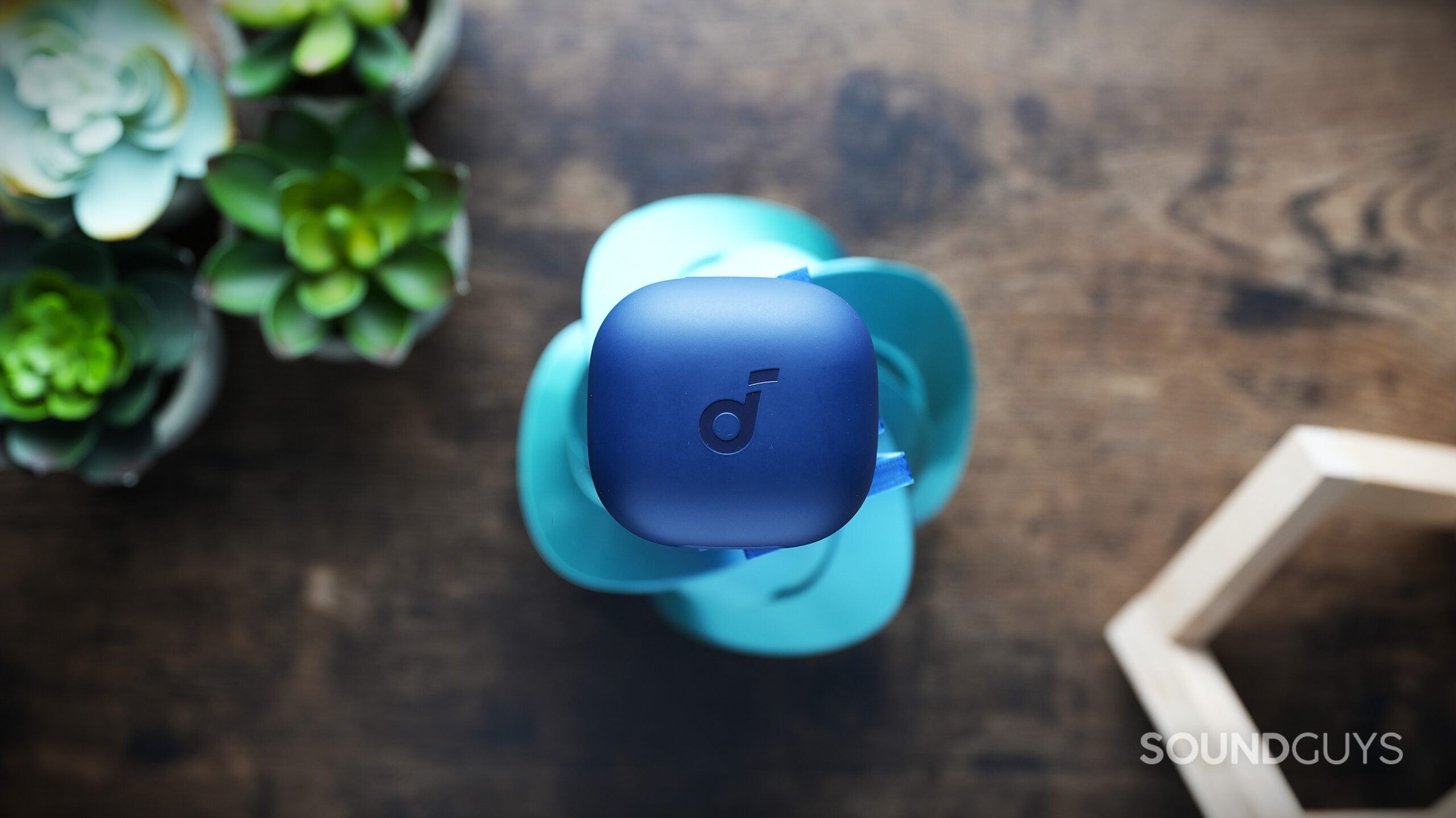

Anker Soundcore P40i review: Bass heavy budget buds
August 29, 2025


Soundcore P40i by Anker
Weight: 54g
The Anker Soundcore P40i attempts to pack premium features into a budget-friendly package, combining active noise cancelation, extensive app customization, and a nifty phone stand feature in the charging case. While they deliver impressive battery life and solid noise isolation, their heavily bass-boosted sound signature and loose fit reveal some compromises inherent in their affordable price point.
The P40i are for budget-conscious listeners who want long battery life and decent noise cancelation but don’t mind a heavily bass-boosted sound signature.
This article was published on August 29, 2025, and this is the first version of the article. Updates will follow as the market changes.
What’s it like to use the Anker Soundcore P40i?
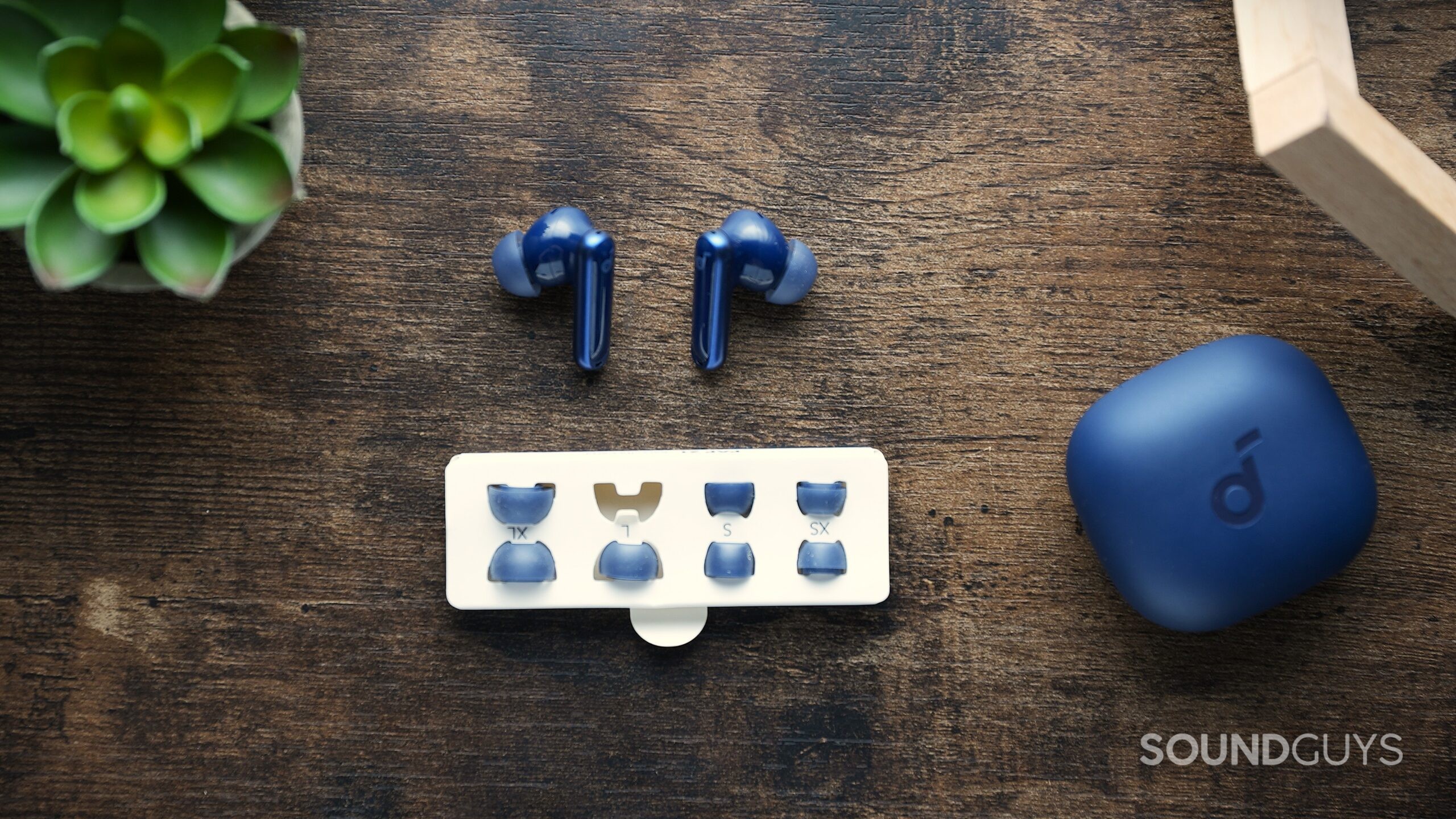
The Anker Soundcore P40i follows the familiar stemmed design language we’ve come to expect from Anker’s true wireless lineup. The sealed, stemmed design houses dynamic drivers in a plastic shell that feels solid without being particularly premium. They are lightweight and have an IPX5 water resistance rating for splash protection; however, I found the fit a bit too loose for working out, requiring some constant readjustments.
The earbuds come with five pairs of silicone ear tips featuring integrated grilles for easier cleaning. However, even with this selection, achieving a secure fit can be challenging for users with larger ear canals.
The compact charging case feels well-constructed and has a secure hinge. LED indicators clearly show each earbud’s battery status, and the case supports Qi wireless charging for added convenience. It fit easily into my pockets and was portable for daily commuting and casual listening.
The P40i uses touch controls along each stem. The control scheme offers good flexibility with single, double, and triple taps plus press-and-hold gestures available on each earbud. Notably, Anker doesn’t restrict you to mirrored functions—you can assign different commands to the same gesture on each bud, like setting double-tap to skip tracks on the left while using it for a voice assistant on the right.
The default control layout covers basic playbook functions, but you’ll likely want to customize it through the app since volume control isn’t available by default. The extensive remapping options allow you to prioritize the functions you use most. However, call-specific controls are more limited compared to media playback options.
Response time is where these controls stumble slightly. The touch sensors don’t react quickly, making the tapping process feel sluggish. This is particularly frustrating when trying to skip backward to the previous track. The buds provide audio feedback with chimes for taps, ANC mode changes, and volume limits, but lack voice prompts for other functions.
What are the best features of the Anker Soundcore P40i?
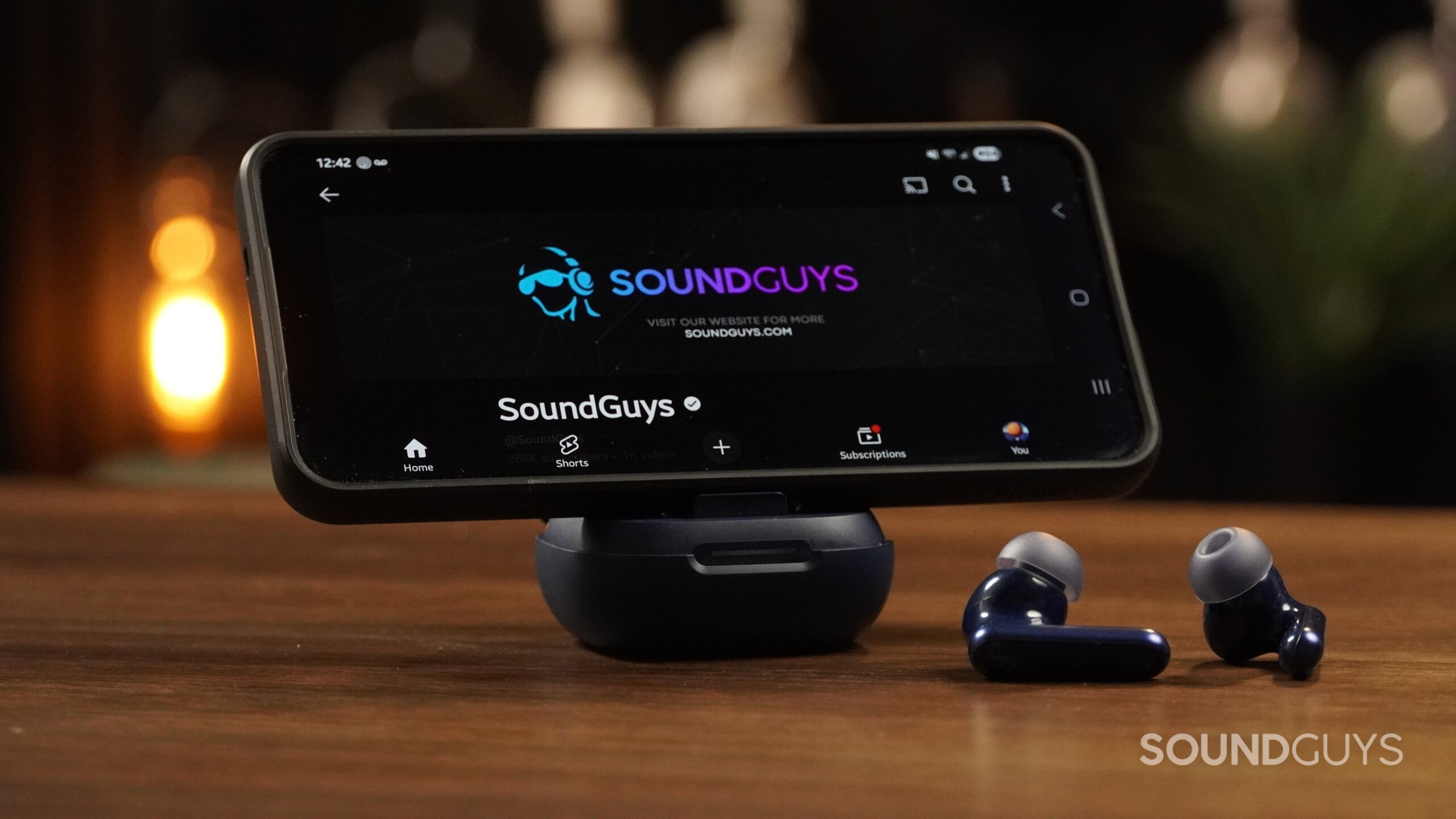
My favorite feature is the charging case’s built-in phone stand. There’s a small plastic tab you can pull up inside the case that holds devices horizontally at a fixed angle. It’s useful for hands-free media viewing during flights or chilling at a coffee shop, especially if you don’t own a phone case with a built-in stand. It’s a simple addition that sets the P40i apart from the other earbuds in Soundcore’s lineup, even if the lack of angle adjustment somewhat limits its utility.
The Anker Soundcore app is also worth downloading, as it adds many features to the earbuds. The custom 10-band EQ allows for decent sound customization, while practical features like Game Mode reduce latency for mobile gaming. Control remapping lets you personalize the touch functions, and the auto-off timer helps preserve battery life. The app also includes virtual surround sound modes, a decibel limiter for hearing protection, and a Find Devices feature for locating misplaced buds. Dual-device management is particularly useful for users who frequently switch between phones and laptops, making the connection process seamless.
How does the Anker Soundcore P40i connect?
The P40i uses Bluetooth 5.3 and supports dual-device pairing, which allows users to switch between a phone and a laptop. Android users also benefit from Quick Pair support. Codec support covers the essentials with SBC and AAC, though you won’t find higher-end options like LDAC that appear on pricier models in Anker’s lineup, like the Liberty 4 NC.
To pair the Anker Soundcore P40i, open the case with the earbuds placed inside. The light on the case will blink to indicate they are in pairing mode. Then, select the Soundcore P40i from your Bluetooth device list.
How long do the Anker Soundcore P40i’s battery last?
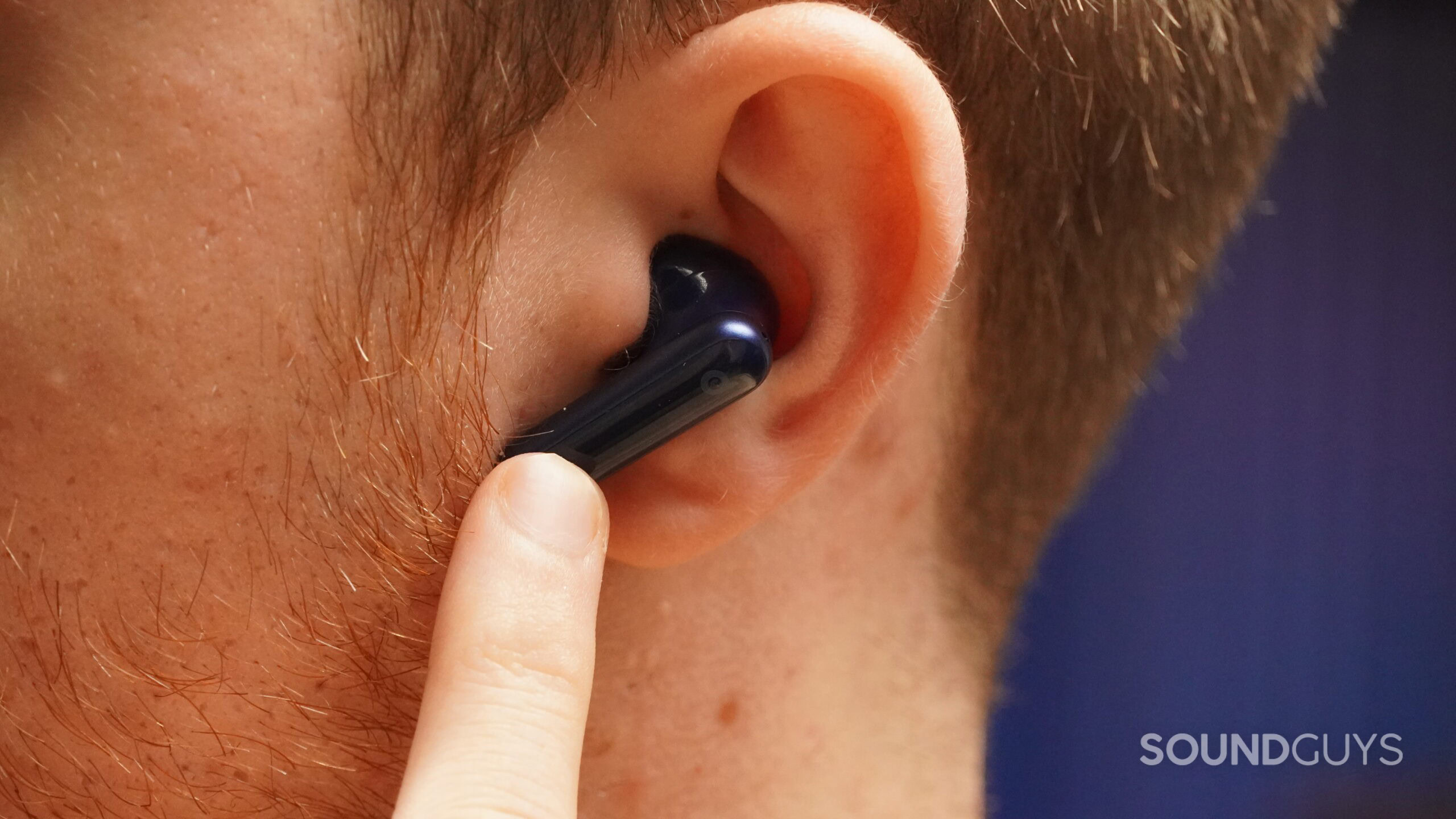
The P40i can easily handle full workdays and then some. Our testing yielded 9 hours and 18 minutes of continuous playback with ANC enabled. Most competitors in this price range only manage around five hours. The charging case adds another four full charges, bringing the total battery life to nearly two full days before you need to find a USB-C cable.
Charging speeds are respectable, with the buds reaching full capacity in about 45 minutes. Anker claims a 10-minute charge provides five hours of playback for quick top-ups. The case itself charges via USB-C and supports Qi wireless charging for added convenience.
The app-adjustable auto-off timer prevents unnecessary drain when you forget to put the buds away. You can also use either earbud independently while the other charges in the case, which is useful for extending listening time.
How well do the Anker Soundcore P40i cancel noise?
The P40i delivers impressive noise isolation that punches well above its price point. The combination of passive isolation and active noise cancelation creates effective full-range attenuation that handles most real-world scenarios admirably.
Loading chart ...
Passive isolation does the heavy lifting for higher frequencies, effectively blocking treble and upper midrange sounds like bird chirping and keyboard clatter. The ANC system takes over in the bass and lower midrange frequencies, successfully attenuating rumbling bus engines, airplane cabin drone, and background office chatter. Street noise becomes much more manageable, with screeching brakes and traffic sounds significantly reduced during commutes.
The app offers various ANC “Scenes” designed to optimize performance for different environments, though I only noticed subtle differences. The most useful was the wind reduction mode, which prevents the howling artifacts that plague many ANC systems in breezy conditions. The system also allows simultaneous use of ambient mode and wind reduction, which still reduces noise compared to having all features disabled.
How do the Anker Soundcore P40i sound?
By default, the Anker P40i has a bass-heavy sound that also leans bright, but the bass emphasis overpowers the treble.
Multi-Dimensional Audio Quality Scores (MDAQS)
The chart below shows how the Multi-Dimensional Audio Quality Score (MDAQS) algorithm from HEAD acoustics assesses the sound of the Anker Soundcore P40i. The sound quality is rated on a scale from 1.0 (very bad) to 5.0 (very good).
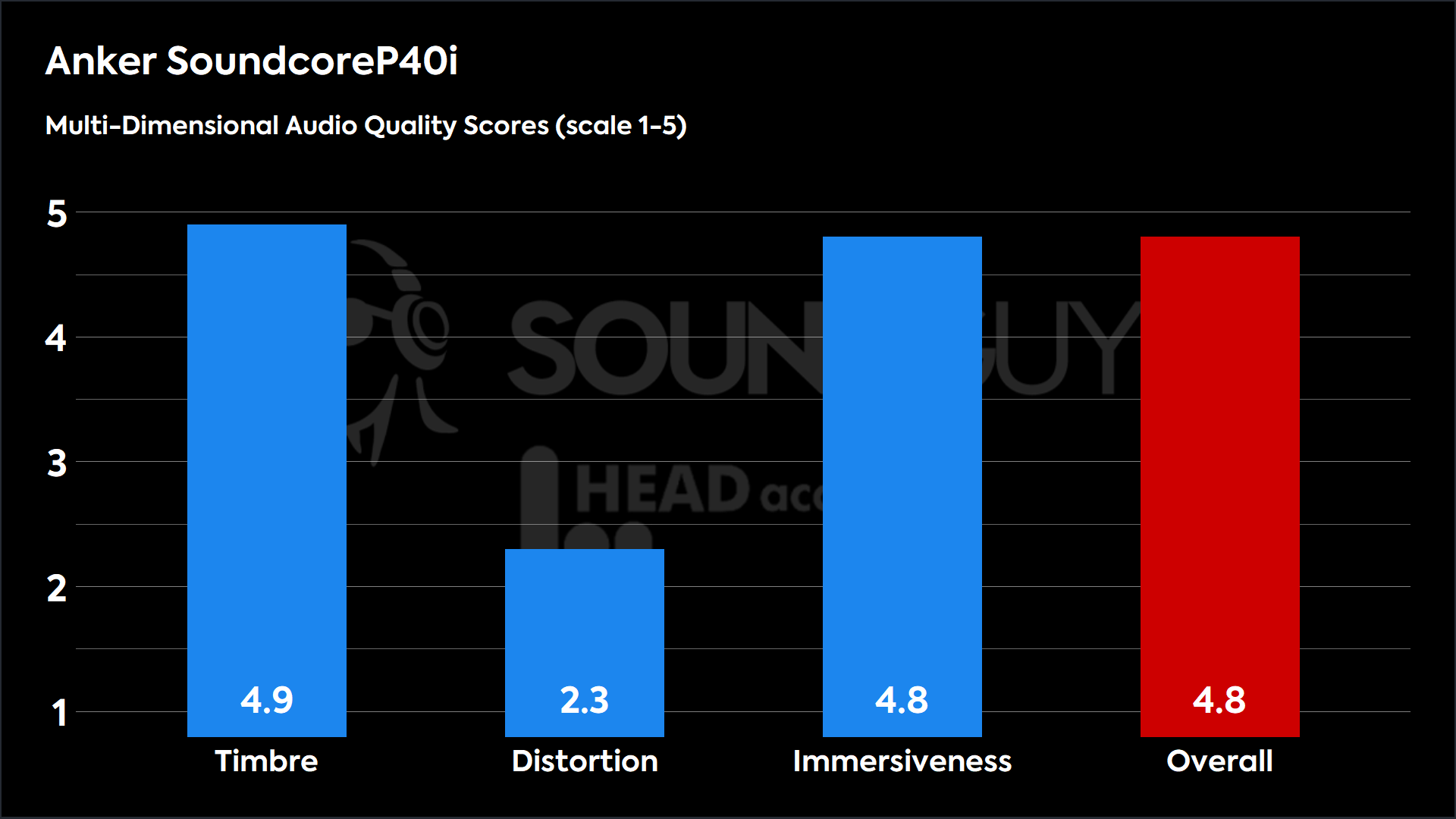
The P40i achieves a solid 4.8 overall MDAQS score, with excellent timbre (4.9) and immersiveness (4.8) creating natural-sounding reproduction and convincing spatial positioning that makes music feel engaging. However, distortion is the weak point at just 2.3, indicating audible artifacts and noise that become noticeable during complex passages or higher volumes. Despite this limitation, the strong overall score demonstrates genuinely good sound quality for budget earbuds that should satisfy most casual listeners.
- Timbre (MOS-T) represents how faithfully the headphones reproduce the frequency spectrum and temporal resolution (timing information).
- Distortion (MOS-D) represents non-linearities and added noise: higher scores mean cleaner reproduction.
- Immersiveness (MOS-I) represents perceived source width and positioning: how well virtual sound sources are defined in three-dimensional space.
See here for an explanation of MDAQS, how it works, and how it was developed.
Reviewer’s notes

Editor’s note: this review uses a hover-enabled glossary to describe sound quality based on a consensus vocabulary. You can read about it here.
Objective Measurements
Loading chart ...
The P40i’s frequency response shows some significant deviations from our preference curve, particularly in the bass and treble regions. There’s a substantial bass boost peaking around 60Hz at roughly 12dB above target. This overemphasis can make these earbuds sound notably boomy and muddy, potentially masking detail in the midrange during bass-heavy tracks.
The low-mid frequencies from 200- 500Hz sit slightly below target, which, combined with the bass boost, creates an unbalanced sound signature that emphasizes thump over clarity. The midrange from 500Hz to 2kHz tracks reasonably close to our preference curve. Vocals and most instruments sound relatively natural. However, the treble region shows a broad peak around 3-5kHz, about 5dB above our target. This treble emphasis can make cymbals, sibilants, and higher-frequency details sound harsh and fatiguing. The overall tuning follows a consumer-friendly V-shaped sound, which may please bass lovers but is not for critical listening.
Bass Boost EQ
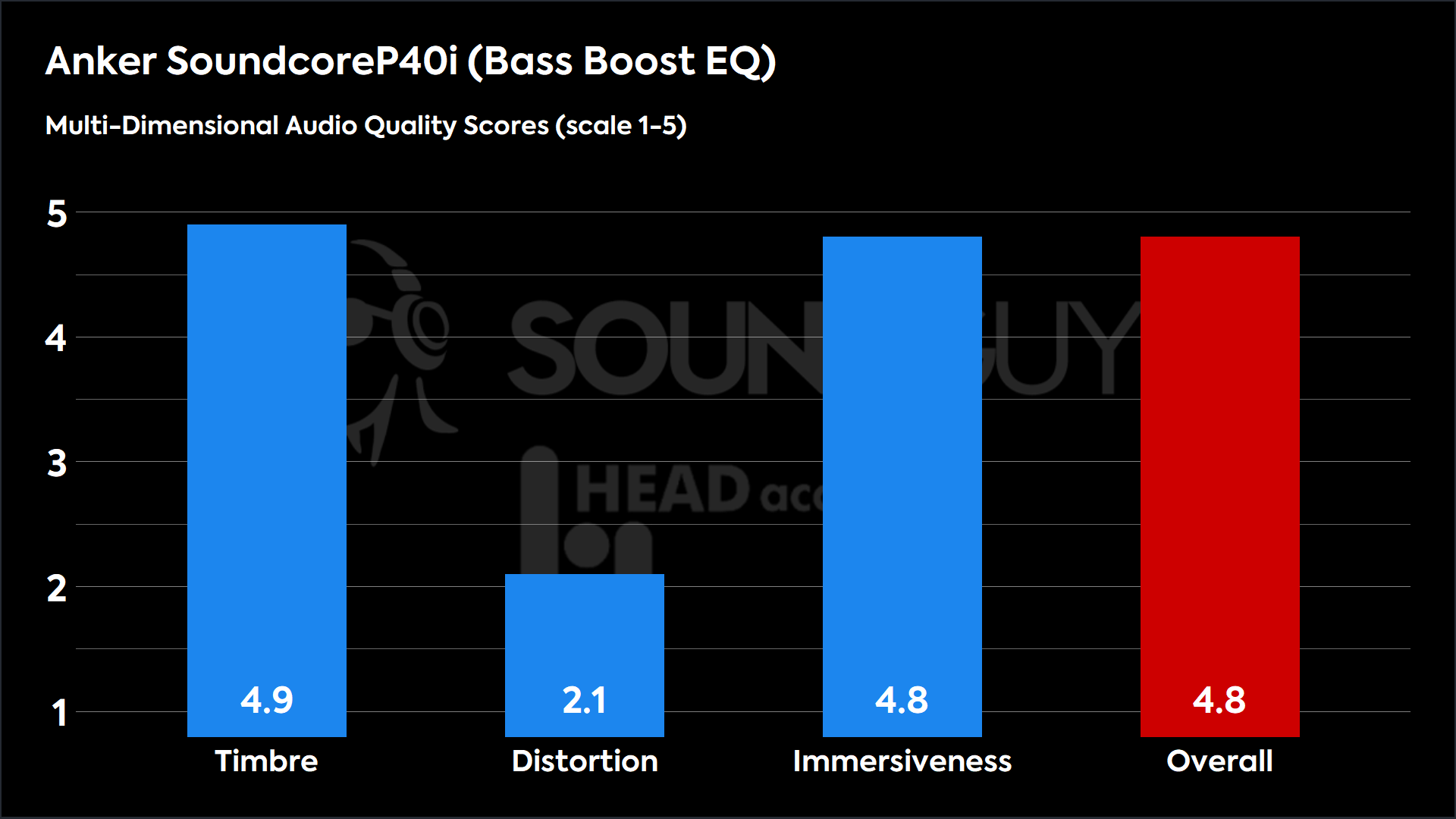
As expected, this preset pushes the low-end even further, creating an even more pronounced bass emphasis. The already boomy character becomes more extreme, which will appeal to listeners who want maximum thump in hip-hop and electronic tracks but will likely overwhelm most other genres. The distortion score drops to 2.1, which makes sense given the increased bass output and higher volumes, which create more audible artifacts and less clean reproduction than the default tuning.
Loading chart ...
Classical EQ
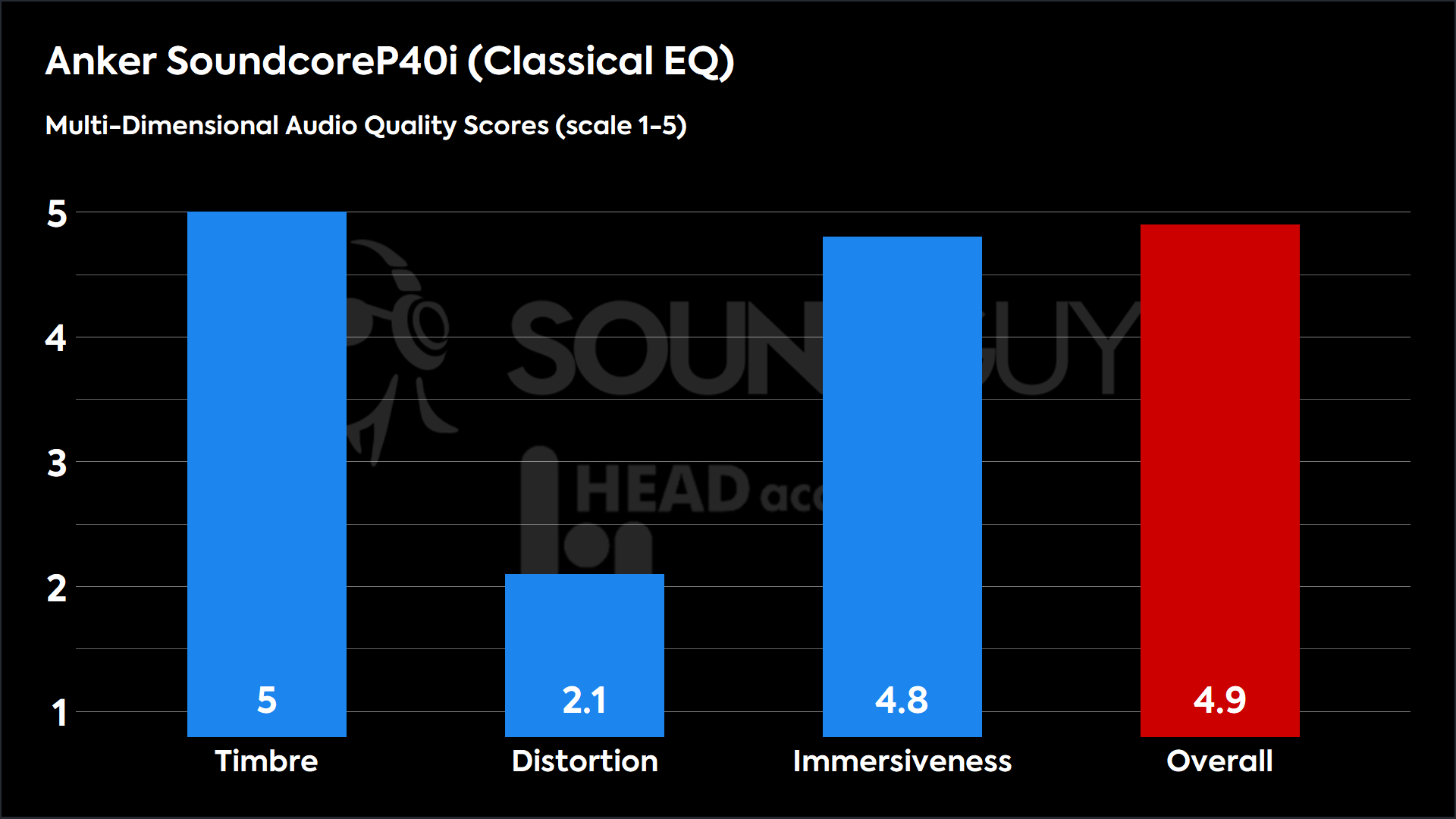
This preset creates an extreme V-shaped sound with bass emphasis remaining just as pronounced as the Bass Boost preset, but now has more scooped mids and adds massive treble boosts in the upper frequencies. This creates a much more aggressive sound signature that’s completely unsuitable for classical music, despite the name. The combination of boomy bass and harsh, overly bright treble makes orchestral recordings sound muddy in the low end and painfully sharp in the highs.
Loading chart ...
Bass Reducer EQ
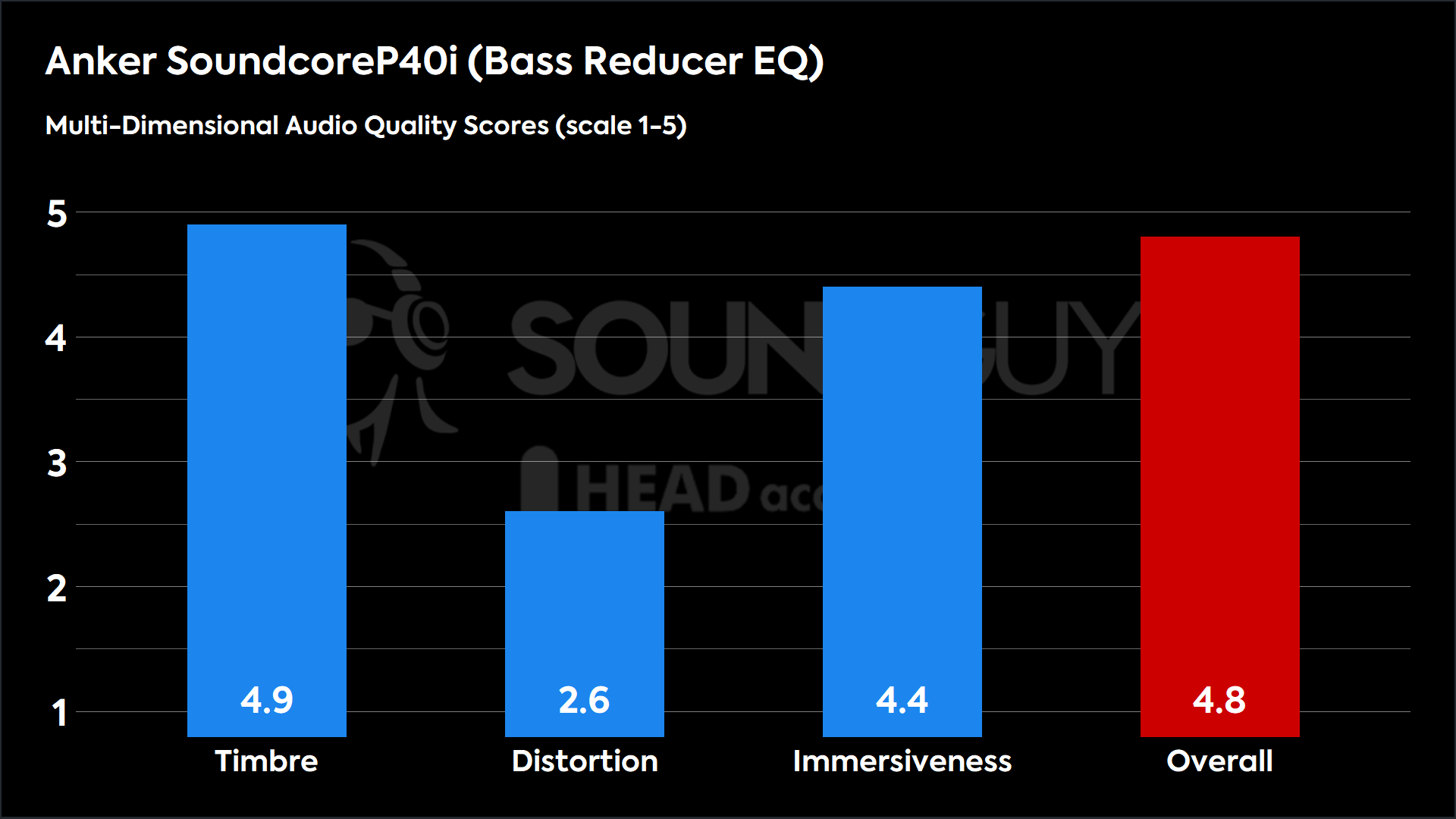
This preset attempts to tame the excessive low-end, bringing the bass emphasis down to a more manageable 10dB above our target around 60Hz—still elevated but significantly less boomy than the default tuning. The treble maintains its bright character with peaks around 3-5kHz and 8-10kHz, creating a sound still V-shaped but less extreme. The distortion score improves slightly to 2.6, while immersiveness drops to 4.4, suggesting the toned-down bass may reduce the sense of spatial impact.
Loading chart ...
Acoustic EQ
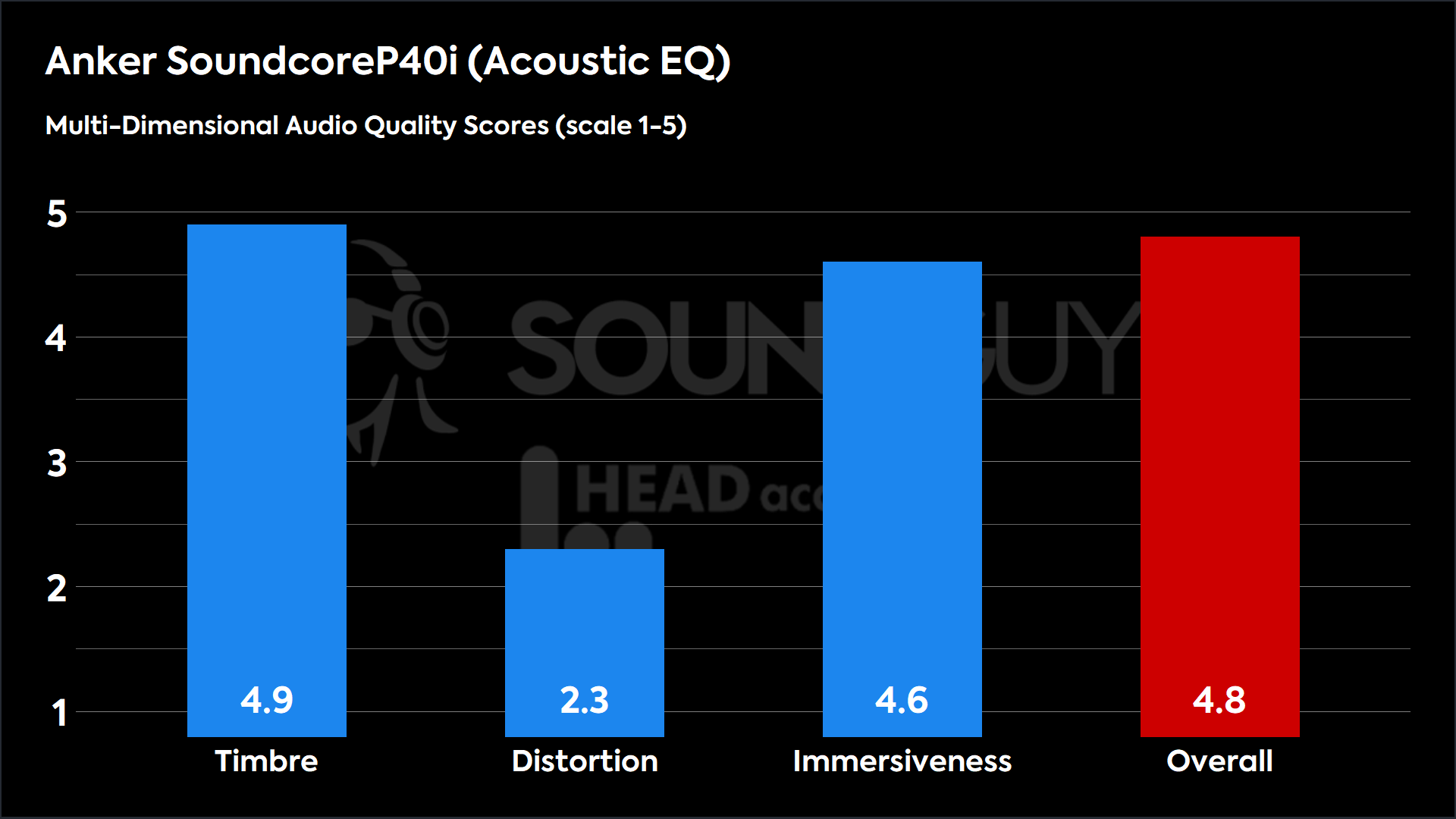
This preset maintains the same bass emphasis as the default tuning and emphasizes the upper treble frequencies beyond 10kHz, creating a slightly brighter sound. The treble peaks reach nearly 10dB above target in the highest frequencies, making acoustic guitar strings, cymbals, and other high-frequency content sound overly sharp and fatiguing. Despite its name suggesting suitability for acoustic music, this tuning can make acoustic guitar recordings sound harsh and unnatural.
Loading chart ...
Can you use the Anker Soundcore P40i for phone calls?
The P40i handles phone calls adequately but doesn’t excel in this area. Voice quality suffers from poor recording reproduction, which makes your speech sound distorted and thin to callers. While you’ll remain intelligible during conversations, the lack of clarity and natural tone means you won’t sound your best on important calls or video conferences.
Anker Soundcore P40i microphone demo (Ideal conditions):
How does the microphone sound to you?
Anker Soundcore P40i microphone demo (Office conditions):
Anker Soundcore P40i microphone demo (Street conditions):
Anker Soundcore P40i microphone demo (Windy conditions):
Anker Soundcore P40i microphone demo (Reverberant space):
Background noise handling shows mixed results. The microphone system does prioritize your voice over ambient sounds, keeping background chatter and environmental noise quieter than your speech. However, the noise suppression can be overly aggressive with sudden or irregular sounds. While it successfully blocks most unwanted noise, it occasionally cuts out small segments of your own speech in the process. This creates brief dropouts that can interrupt the flow of conversation, though it’s preferable to having loud, unexpected noises blast through to the caller.
Should you buy the Anker Soundcore P40i?
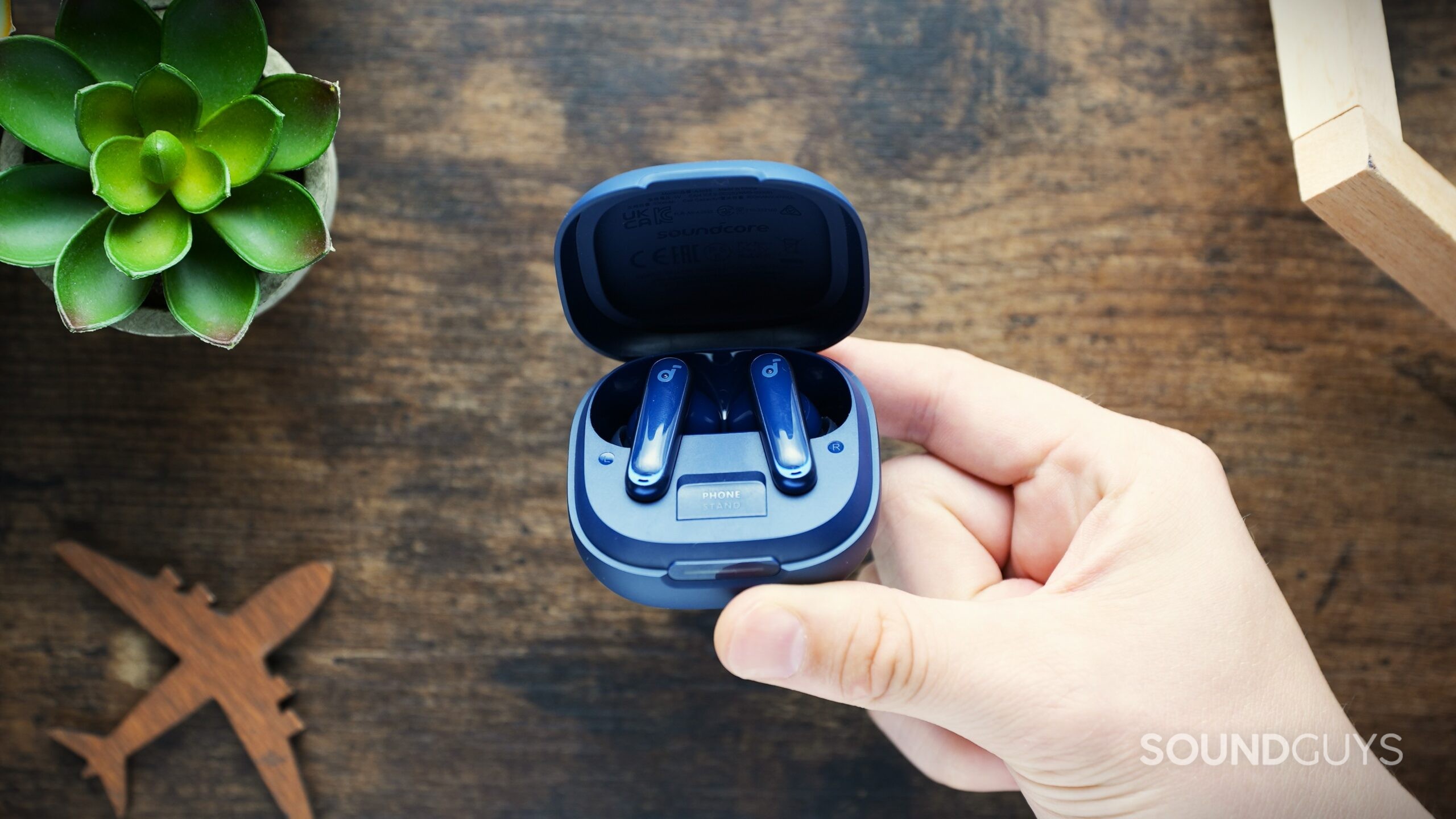
The P40i is a mixed bag that succeeds in some areas while failing in others. If you’re a budget-conscious listener who enjoys bass-heavy music and needs long battery life, effective noise cancelation, and extensive app customization, these earbuds deliver solid value. The unique phone stand also adds practical utility, differentiating it from generic competitors.
However, the P40i’s loose fit makes them unsuitable for workouts or active use, while the heavily bass-boosted sound signature will frustrate critical listeners. The poor microphone quality rules them out for frequent phone calls, and the sluggish tap controls can be genuinely irritating during daily use.
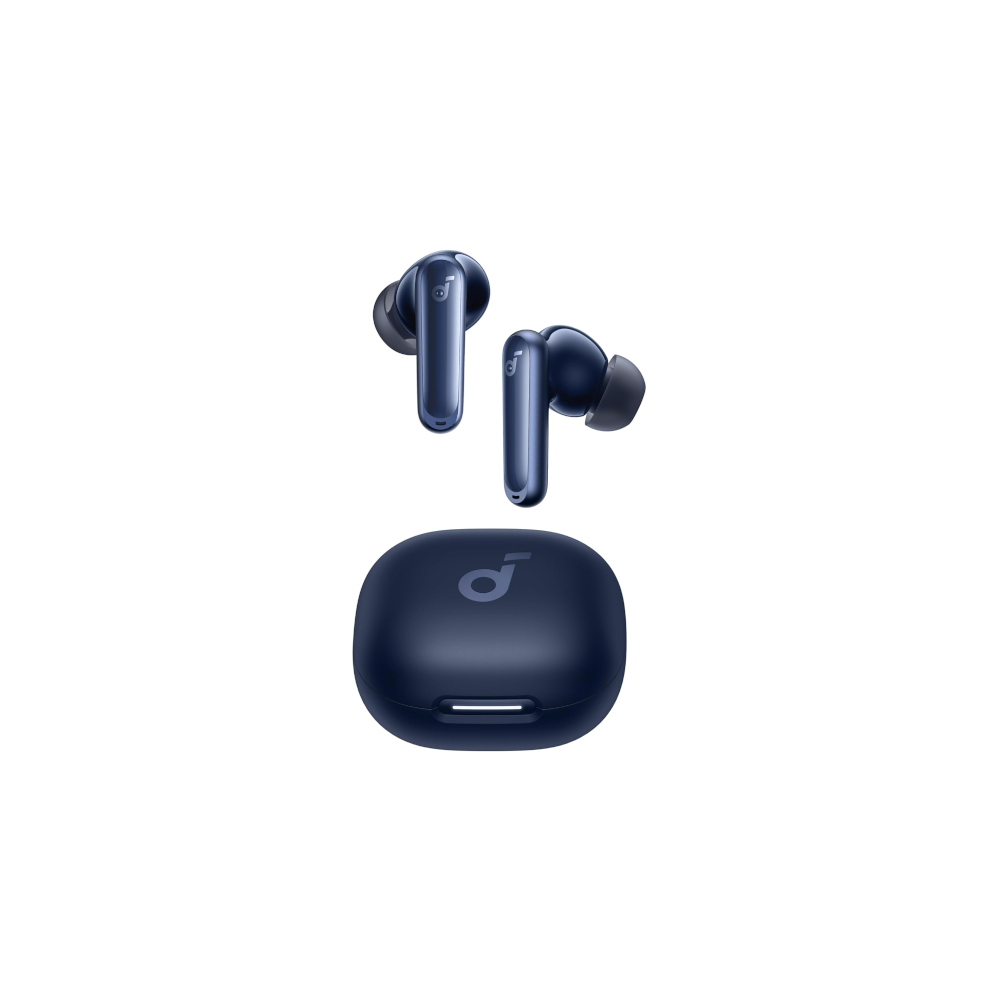

For most users, the P40i work best as secondary earbuds for casual listening scenarios—commuting, background music during work, or relaxed listening where their noise cancelation and long battery life shine. If audio quality, secure fit, or call performance are priorities, you’ll want to consider alternatives even if it means spending more. The P40i delivers exactly what their price point promises: functional earbuds with some nice extras, but with clear compromises that remind you why they cost so little.
What should you get instead of the Anker Soundcore P40i?
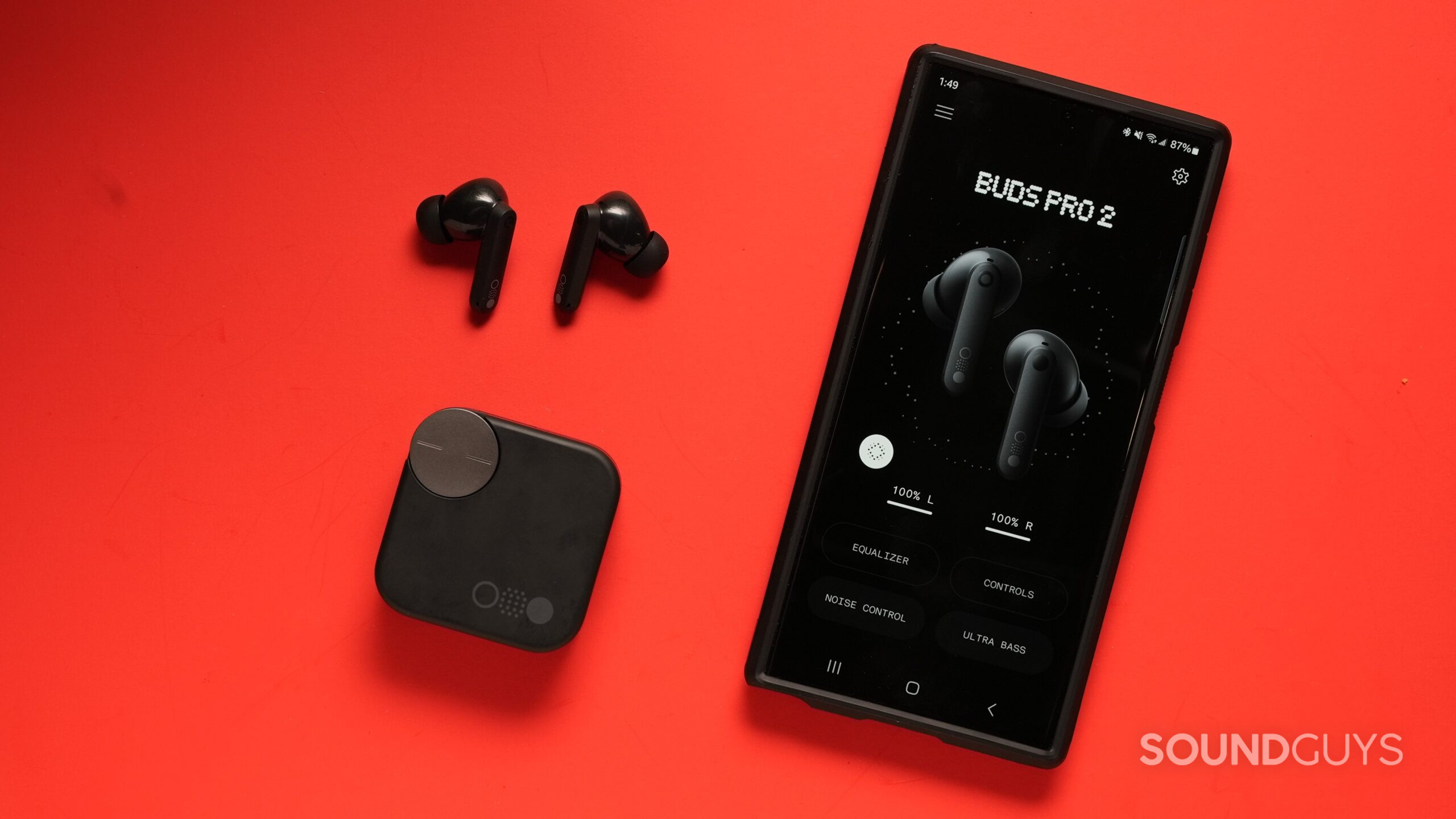
- CMF Buds Pro 2 ($59 at Amazon): These offer a more balanced sound signature with warmer treble that’s less fatiguing than the P40i’s harsh peaks, plus superior microphone quality and LDAC codec support for high-resolution audio. However, you’ll sacrifice some battery life and the P40i’s more comfortable fit with its wider ear tip selection.
- Anker Soundcore Liberty 4 NC ($99.99 at Amazon): Step up within Anker’s own lineup for LDAC codec support and similar app functionality, though you’ll lose the P40i’s Game Mode latency advantage and slightly better IPX5 water resistance. The sound signatures remain similarly bass-heavy across both models.
- Anker Soundcore Space A40 ($79 at Amazon): Another Anker alternative that adds LDAC support and reduces audio leakage while maintaining comparable noise isolation performance. The trade-offs include shorter battery life, less secure fit during movement, and downgraded IPX4 water resistance compared to the P40i’s IPX5 rating.
Anker Soundcore P40i review: FAQs
No, they're water-resistant with an IPX5 rating, meaning they can handle splashes and light rain but aren't waterproof. Don't submerge them in water or wear them swimming.
Yes, they work with both iPhone and Android devices via Bluetooth. Android users get Quick Pair support for faster initial setup.
Yes, the charging case supports Qi wireless charging in addition to USB-C wired charging.
No, they don't support lossless audio codecs. The highest quality codec available is AAC.
Thank you for being part of our community. Read our Comment Policy before posting.